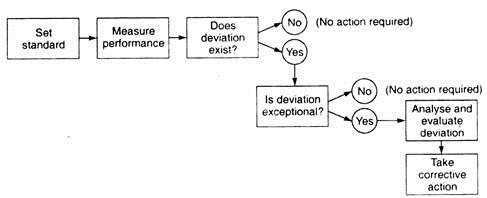This article throws light upon the three main aids used in managerial control. The aids are: 1. Management by Exception (MBE) 2. Management Information Systems (MIS) 3. Key Indicator Management.
Aid # 1. Management by Exception (MBE):
Management by exception, or the exception principle enables managers to direct attention to the most critical areas of control and permits employees or lower levels of management to handle routine variations Fig.17.9.
Fig. 17.9: Management by Exception
The technique can be practised by managers in sales, production, finance, personnel, purchasing, quality control, and other functional areas. Even first line managers can make use of this principle in their daily supervision. In short, MBE refers to the conscious decision on the part of a manager to enter into a situation on a ‘needs’ basis where the particular manager is needed to make decision.
An Example:
A simple example may explain how this principle works in practice. Suppose, for a hypothetical company, the sales target for January was fixed at Rs. 1,00,000, but on Feb. 8, the sales report for January came to president (sales). The actual value of sales for the month was Rs. 95,000 or 5% below the forecast figure.
The basic question here is whether a 5% deviation from the sales target for the first month is an exceptional one.
Perhaps the president has agreed with the sales vice-president that so long as sales fall within 10% of the forecast the matter of exercising control will be delegated to the vice-president. But, sales deviating from the target by more than 10% would be considered as exceptional deviation from the standard, and the president himself(herself) would take active role in exercising control.
He might like to be briefed by the sales vice-president, find out what is causing the problem, and take corrective action to recover the lost ground in the next two months (February and March) so that the quarterly performance (i.e., performance in the first quarter January – March) could be attained. It may also be noted that if sales performance exceeded expectations and was Rs. 1,10,000, the president would also become active in exercising control.
Aid # 2. Management Information System (MIS):
A management information system (MIS) plays an important role in management’s effective performance of the planning and controlling functions of the management. From the point of view of managerial control, an MIS is most helpful in providing timely, relevant information so that managers can make greater use of two types of control: feed forward and concurrent.
Definition:
An MIS may simply be defined as “a planned system of gathering, processing, storing and disseminating information so that effective management decisions can be made.”
The concept of MIS is closely relating to computer technology. There are, of course, organisations having an MIS without a computer, but the system will be less sophisticated without such assistance.
The MIS is an attempt to deal with huge cost, revenue, inventory, payroll and other data in an orderly timely manner so that needed information is placed in the management’s hands in the right form and at the right time. Thus an MIS serves management by providing the right person with the right amount of relevant information at the right time.
MISs have advanced the quality and timeliness of the data available to management in the following areas:
We will speak more about MIS in the Appendix to this title.
Aid # 3. Key Indicator Management:
Key indicator management (KIM) is one of the most recent monitoring systems that furnishes managers with information which, at a glance, provides the essentials they need. Such an approach focuses on charts, tables, or graphs to keep track of the key measures of company operations.
For each measure, a target is established and a monthly report prepared to show progress (or lack thereof) against a particular goal. Just by concentrating on the indicator, rather than watching an entire operation, the manager can take corrective actions. If the key indicator is not on target, the manager must conduct further investigation into the operation.
KIM is an extension and application of MBO and participative management. Under the system department heads, including the person in charge of the MIS department, select the targets and measuring devices through conferences with their supervisors.
This general management control technique helps companies as a feed-forward control inasmuch as it highlights trends along with interim or temporary successes and failures.
KIM is an ongoing monitoring system in the sense that it keeps track of operations as they progress. By using this method it is possible to watch over any key area or a project on a temporary or permanent basis.
The following five steps are involved with KIM system of monitoring:
1. Identification of the operating departments or functions to be measured.
2. Determination of the items to be used in the measuring programme.
3. Determining the measurement details.
4. Establishment of the targets (goals).
5. Preparation of a periodic report.
The process used by management is a simple one. Just the areas of functions have to be identified. Therefore critical items in each department which have to be monitored are selected. The next phases involve exactly how to measure the success of these indicators and goal establishment by management.
Therefore, reports are generated in time frames directed by management. Steps 1 to 4 enable the manager to isolate the factors that are critical to the success of the function.
